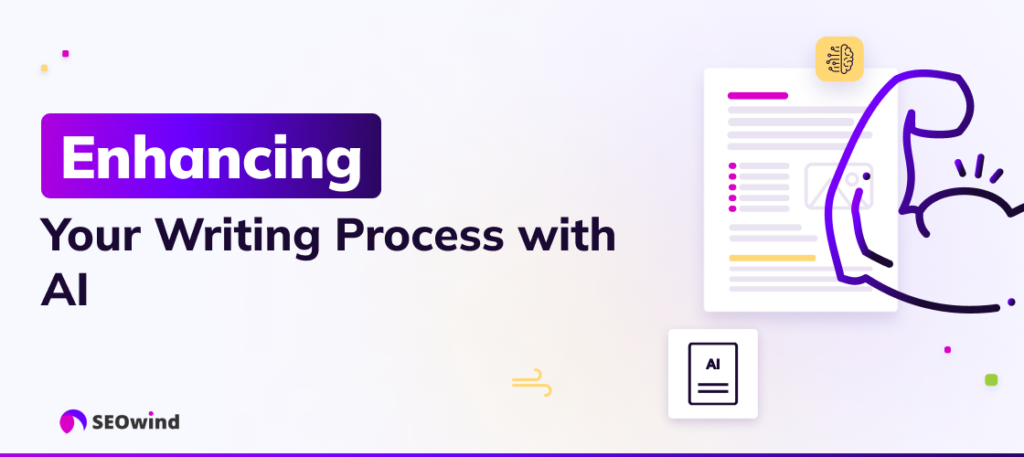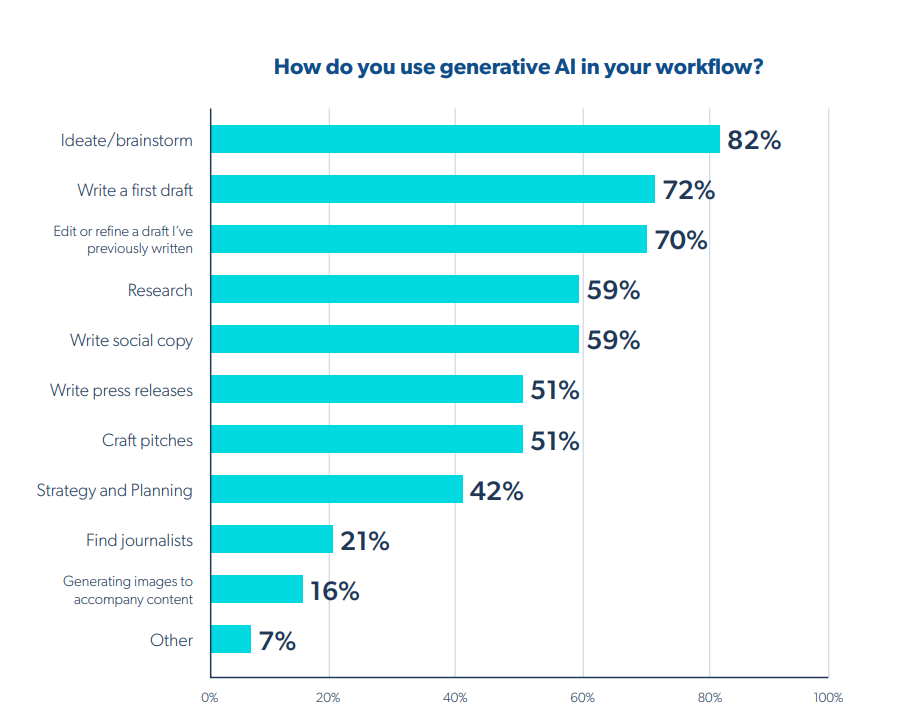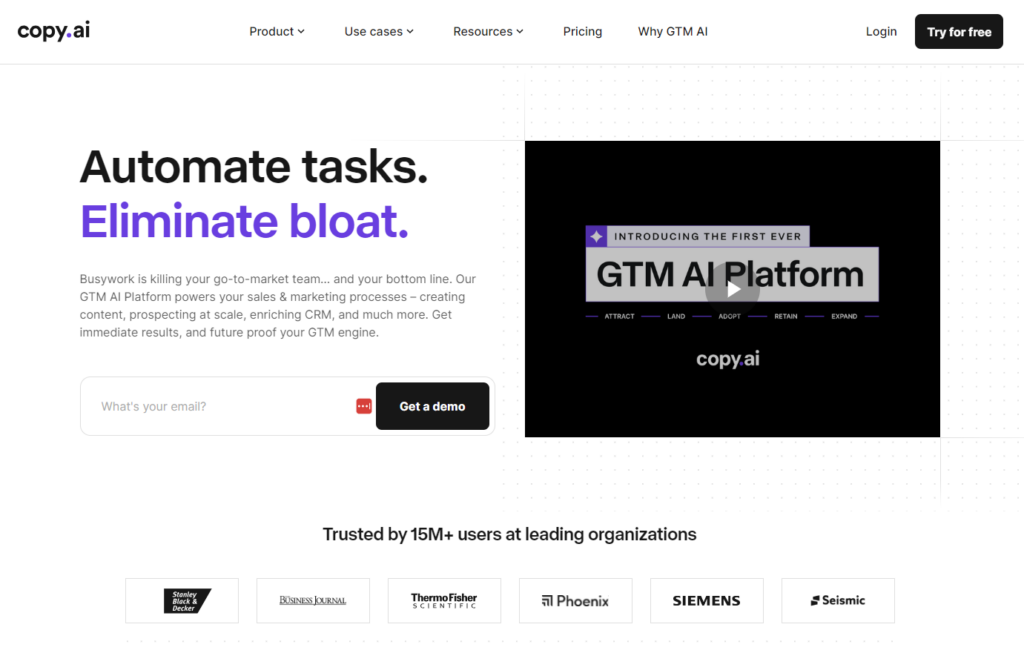Ever stared at a blank page feeling completely stuck? Or you’ve had too many ideas and couldn’t figure out how to organize them. You’re not alone, and AI writing tools can help. AI has changed content creation, becoming a powerful ally for writing better, faster, and more engaging content. From sparking fresh ideas to polishing your sentences, AI can enhance your writing process while letting your unique voice shine through. This guide will show you how to artificial intelligence to write without sacrificing authenticity or quality.
Enhancing Your Writing Process with AI

Artificial intelligence has become invaluable for content creators, offering tools that streamline work and improve results. Recent data shows that content optimized with AI-driven insights generates 83% higher engagement rates than traditional methods. Using AI throughout your workflow, you can transform every stage of your writing journey.
Generating Ideas and Topics
Finding fresh, engaging topics is often one of the biggest writing challenges. AI excels at analyzing tons of data, including trending topics, search queries, and user behavior, to generate relevant content ideas tailored to your niche.
Just input a broad topic or keyword into an AI tool to get potential article ideas with suggested angles and subtopics. This not only saves time but reveals unique perspectives you might have missed. AI can also identify content gaps in your niche, helping you create material that addresses your audience’s unanswered questions.
A recent study The State of AI in PR 2025 shows that 82% of PR professionals worldwide use generative AI for ideation and brainstorming. This shows how effective it is at this crucial stage.

Creating Detailed Outlines
A solid outline sets the foundation for cohesive, well-structured content. AI writing tools are great at organizing thoughts and developing robust frameworks that ensure logical flow.
AI can generate detailed outlines with suggested headings, subheadings, and bullet points for each section by providing your main topic and key points. These AI-generated outlines serve as excellent starting points that you can refine to match your specific goals and voice. This approach ensures you cover topics thoroughly while saving significant time in the planning phase.
According to the 2023 Deloitte Digital Transformation Survey, organizations report average cost reductions of 32% after implementing AI content tools, with efficiency gains coming from multiple sources, including streamlined outlining and planning processes.
Note: There are tool dedicated to create detailed outlines based on in-depth research and insights. Check out SEOwind Content Brief Generator for this.
Writing the First Draft
The first draft is often the most time-consuming part of content creation. Still, AI can significantly speed up this phase without sacrificing quality. AI writing assistants can generate paragraphs or sections based on your outline and key points.
While AI-generated drafts provide a solid foundation, they work best as springboards for your ideas. The goal isn’t to replace your unique perspective but to enhance it with AI-powered assistance, especially when facing tight deadlines or writer’s block.
Note: Current AI writing tools that are based on in-depth research, AI workflows and AI agents can generate good quality EEAT articles and blog posts. They can serve as a great starting point for writing content that ranks. Checkout SEOwind AI Article Writer.
Adjusting Language and Style to Specific Audience
One of AI’s most valuable capabilities is adapting language and style to suit specific audiences. Whether writing for technical experts, casual readers, or business professionals, AI can help fine-tune content to resonate with target readers.
AI tools analyze text and suggest improvements to enhance readability, adjust tone to match your desired style, and recommend more impactful vocabulary. This feature is beneficial when maintaining a consistent brand voice across various assets or writing for different platforms with distinct audience expectations.
Recent data shows that AI copywriting tools improve ad click-through rates by 38% while reducing cost-per-click by 32%, demonstrating the effectiveness of AI-optimized messaging when properly implemented.
AI Writing and Search Engine Guidelines
As AI content generation becomes more common, search engines have evolved their evaluation methods. Understanding how AI-generated content aligns with search guidelines, particularly Google’s E-E-A-T standards, is crucial for creating compelling, rankable content.

Understanding Google’s Position on AI-Generated Content
Google’s stance on AI content has changed significantly in recent years. Current guidelines indicate that Google doesn’t penalize content simply because it’s AI-generated. Instead, they focus on quality, relevance, and value to users, regardless of how it’s created.
According to Google’s latest guidelines, “appropriate use of AI or automation is not against our guidelines” as long as it isn’t primarily used to manipulate search rankings. Google now claims it focuses on “the quality of the content, rather than how it is produced.”
However, Google is also working to reduce low-quality AI content created specifically for search engine rankings. While AI content is acceptable, it must meet high-quality standards to perform well.
E-E-A-T Standards and AI Content
E-E-A-T (Experience, Expertise, Authoritativeness, and Trustworthiness) remains central to Google’s content evaluation framework. When using AI tools, ensuring your content demonstrates these qualities is essential:
Experience: Include real-world experiences and case studies that AI alone cannot provide. According to content ethics expert Dr. Maya Hernandez, “AI can generate text, but it cannot replace lived experience. The most valuable content combines AI efficiency with genuine human perspectives derived from real-world applications.”
Expertise: Add specialized knowledge and industry insights to AI-generated content. Review factual information for accuracy and provide in-depth explanations that show genuine understanding of complex topics.
Authoritativeness: Build authority by adding unique analysis and citing reputable sources. According to the Deloitte Digital Transformation Survey, human-AI collaboration produces content that demonstrates 47% better expert authority ratings compared to purely AI-generated content.
Trustworthiness: Be transparent about using AI tools while emphasizing human oversight. As Tom Winter states, “Transparency in AI use builds trust. Organizations should clearly communicate their AI usage policies while emphasizing the human judgment and expertise that guides the final content.”
Strategies for Creating AI Content That Meets Search Engine Requirements
To create AI-generated content that performs well in search results while following quality guidelines, consider these strategies:
- Focus on providing genuine value rather than just satisfying algorithms. Content should thoroughly address user needs with actionable insights.
- Structure content for clarity and readability, with logical heading hierarchies, proper paragraph breaks, and meaningful transitions between topics.
- Add unique insights and proprietary data not available elsewhere, such as internal research findings or expert commentary.
- Include multimedia elements like images, videos, and interactive features that enhance user experience and engagement.
- Implement rigorous fact-checking processes to ensure accuracy. AI can sometimes generate “hallucinations” or outdated information that requires human verification.
By following these guidelines, you create AI-assisted content that meets search engine requirements and genuinely helps your audience, which is ultimately what users and search engines value most.
Ethical Considerations in AI Content Creation

As AI writing tools become more sophisticated, creators face important ethical questions about their use. Addressing these concerns proactively helps maintain audience trust and ensures responsible content practices.
Transparency and Disclosure
Being transparent about AI use in content creation builds audience trust and aligns with emerging ethical standards. Tom Winter, AI Consultant, states, “Transparency in AI use builds trust. Organizations should clearly communicate their AI usage policies while emphasizing the human judgment and expertise that guides the final content.”
Consider implementing these transparency practices:
- Develop a clear policy on when and how AI is used in your content creation
- Decide whether to disclose AI use directly in content or in a general policy statement
- Balance transparency against unnecessary disruptions to the reader experience
- Monitor evolving industry standards and regulatory requirements regarding AI disclosure
The level of disclosure may vary based on content type, audience expectations, and your organization’s values. What matters most is having a thoughtful, consistent approach.
Avoiding Bias and Misinformation
AI systems can unintentionally perpetuate or amplify biases present in their training data. They can also generate plausible-sounding but incorrect information, which experts call “hallucinations.”
“Generative AI uses machine learning to infer information, which brings the potential inaccuracy problem to acknowledge. Also, pre-trained large language models like ChatGPT are not dynamic in keeping up with new information,” according to a 2023 study on AI ethics.
To reduce these risks:
- Always fact-check AI-generated content, especially statistics, quotes, and technical information
- Be aware of potential bias in how topics are framed or which aspects are emphasized
- Use diverse prompts and review content with attention to inclusivity and representation
- Implement a multi-step review process for sensitive or high-stakes content
- Keep AI-generated content updated as information and understanding evolve
Copyright and Originality Concerns
The relationship between AI-generated content and copyright law remains complex and evolving. Content marketers should understand the potential issues to avoid legal and ethical problems.
“Who owns AI-generated content? The company or individual using it, or the company that owns the generative AI tool that created it? Ethical concerns arise when there is ambiguity regarding the ownership of AI-generated material and the potential legal exposure for individuals or organizations that publish it without proper authorization,” notes a recent analysis of ethical considerations in AI content.
To navigate these concerns:
- Understand the terms of service for any AI tools you use
- Avoid using AI to closely mimic specific authors’ styles without permission
- Don’t rely on AI to generate content based on copyright-protected material
- Consider how AI-generated content fits into your overall originality standards
- Stay informed about evolving legal precedents regarding AI and intellectual property
Maintaining Content Quality and Value
The most fundamental ethical consideration is ensuring AI-enhanced content provides genuine value to your audience. Using AI to generate low-quality, duplicate, or unnecessary content harms your audience relationship and brand reputation.
Content marketing expert Jason Rodriguez emphasizes, “When using generative AI content, it’s essential to know your actions’ potential implications and consequences. You need a code of ethics to guide your behavior as an individual and an organization.”
Ethical AI content creation focuses on:
- Solving real audience problems or answering genuine questions
- Adding unique insights rather than repackaging existing information
- Maintaining editorial standards regardless of how the content is produced
- Using AI to scale value creation, not just content production
- Regularly evaluating whether AI use aligns with your organization’s values
By addressing these ethical considerations thoughtfully, content creators can leverage AI’s benefits while building sustainable, trusted relationships with their audiences.
Choosing the Right AI Writing Software

With so many options available, selecting the best AI writing tool for your needs can be challenging but crucial for maximizing productivity and content quality. This decision should be based on your requirements, content types, and how each tool fits into your workflow.
Criteria for Selecting AI Writing Tools
When evaluating AI tools for writers, consider these key factors:
- Accuracy and Quality of Output: The primary goal is to enhance your content. Recent data shows AI-assisted blog writing tools have demonstrated the ability to increase organic traffic by 120% within 6 months. Still, results vary significantly between platforms, making testing essential before committing.
- Ease of Use: Look for an intuitive interface that doesn’t require extensive technical knowledge. User-friendly platforms allow you to focus on writing rather than struggling with complex software.
- Customization Options: Every writer has a unique style and voice. Choose AI tools that adapt to match your tone, brand voice, and specific requirements.
- Integration Capabilities: Consider how the tool fits into your existing workflow and integrates with other software. Seamless integration can significantly boost productivity.
- Versatility: The best AI tools should handle various content types, from blog posts to social media updates and product descriptions.
- Learning Curve and Training: Consider how quickly you can become proficient with the tool. Some AI writing software requires more training but offers more advanced features.
- Pricing and Value: Consider your budget and the value provided. Many tools offer tiered pricing plans, allowing you to start small and scale as needed.
- Data Security and Privacy: Ensure the AI software follows strict data protection standards, especially when handling sensitive information.
- Regular Updates and Improvements: Choose tools that receive frequent updates to stay current with evolving AI capabilities and best practices.
Decision Framework: Matching Tools to Your Specific Needs
Different content creation scenarios call for different AI writing tools. Use this framework to determine which solution best fits your requirements:
| Content Type | Priorities | Key Features | Tool Categories |
|---|---|---|---|
| For Long-Form Content Creation (Articles, Reports, Guides) | Advanced outlining capabilities, research assistance, factual accuracy, SEO optimization | Document structure templates, content brief generation, citation management | Comprehensive content platforms, specialized long-form assistants |
| For Marketing and Conversion Copy | Persuasive language suggestions, A/B testing capabilities, conversion optimization | Template libraries for ads/emails, headline generators, emotional analysis | Specialized copywriting tools, marketing-focused platforms |
| For Social Media and Short-Form Content | Tone flexibility, platform-specific formatting, trending content insights | Character counting, platform presets, hashtag suggestions | Social media management platforms with AI components |
| For Technical or Specialized Writing | Industry-specific terminology, formatting standards, reference management | Technical glossaries, citation tools, specialized templates | Domain-specific AI assistants, customizable platforms |
| For Collaborative Team Environments | Multi-user access, version control, approval workflows | Team permission settings, collaborative editing, content calendars | Enterprise content platforms, workflow management systems |
When evaluating tools against this framework, consider not just your current needs but how they might change as your content strategy grows.
Top 3 AI Writing Platforms and Their Unique Features

As the demand for AI writing tools continues to grow, several platforms have emerged as leaders in the field. Let’s compare three top-tier AI writing platforms, each with unique strengths tailored to different writing needs..
| Feature | SEOwind | Jasper | Copy.ai |
|---|---|---|---|
| Primary Strength | SEO-optimized long-form content | Versatile content creation | Short-form creative content |
| Best For | Blog posts, articles, in-depth guides | Marketing teams, varied content types | Social media, ad copy, emails |
| SEO Capabilities | Advanced SERP analysis, competitor insights, secondary keywords analysis, EEAT evaluation | Good (with Surfer SEO integration) | Basic |
| Unique Feature | CyborgMethod™ workflow AI workflows and AI Agents built in | Boss Mode for long-form control | Extensive template library |
| Content Types | Long-form, SEO-optimized articles | All content types (50+ templates) | Short-form content, marketing copy |
| Learning Curve | Medium | Medium | Low |
| Collaboration | Yes | Yes, team features | Limited |
| Languages | English-focused available in 15 languages | 25+ languages | Multiple languages |
| Pricing Structure | Project-based, subscription | Monthly subscription | Freemium, subscription |
SEOwind – best AI tool for article writing

SEOwind specializes in SEO-optimized long-form content creation. Here’s what makes it stand out:
- SEO-Focused Content Generation: SEOwind uses advanced algorithms to analyze top-ranking content for your target keywords, ensuring your articles are optimized for search engines.
- Built in AI workflows and AI agents: SEOwind is advanced tool combining research, evaluation and refinment – all to increase E-E-A-T of your content
- Customizable Content Briefs: The platform generates detailed content briefs based on competitor analysis, giving you a solid foundation for your articles.
- AI-Powered Writing Assistant: SEOwind’s AI writing tool helps you create high-quality content faster, suggesting relevant information and helping maintain a consistent tone throughout your article.
- Content Structure Recommendations: SEOwind offers suggestions for headings, subheadings, and overall article structure based on top-performing content in your niche.
- Great for writing briefs, AI articles and doing content updates

Jasper
Jasper, formerly known as Jarvis, is a versatile AI content-writing software that caters to a wide range of writing needs. Here’s what makes Jasper stand out:

- Multiple Writing Templates: Jasper offers over 50 templates for various content types, from blog posts to ad copy, making it a versatile choice for different writing tasks.
- Long-Form Assistant: The Boss Mode feature allows you to create longer content pieces with more context and control.
- Integration with Surfer SEO: This integration enhances the platform’s SEO capabilities, helping optimize your content for search engines.
- Multilingual Support: Jasper can generate content in over 25 languages, making it an excellent choice for businesses with a global audience.
- Team Collaboration Features: The platform allows multiple users to work on projects simultaneously, enhancing team productivity.
Copy.ai

Copy.ai is an AI-writing tool that excels at creating short-form content and helping with creative ideation. Here are its key features:
- Extensive Template Library: Copy.ai offers numerous templates for various content types, including social media posts, product descriptions, and email subject lines.
- Idea Generation: The platform is particularly valuable when it comes to brainstorming and generating creative ideas for marketing campaigns and content strategies.
- User-Friendly Interface: Copy.ai’s intuitive design makes it easy for beginners to use AI for content creation.
- Tone Customization: The software allows you to adjust the tone of your content to match your brand voice or target audience.
- Quick Content Generation: Copy.ai is especially efficient at producing short-form content quickly, making it ideal for social media managers and marketers.
Each platform offers unique features tailored to specific content creation needs. When choosing among these AI writing tools, consider your primary content types, workflow requirements, and how each tool complements your existing process.
Case Studies: Real-World Success with AI Writing
While the theoretical benefits of AI writing tools sound great, real-world examples provide concrete evidence of their impact. These case studies show how organizations have achieved measurable improvements after implementing AI writing solutions.
The Washington Post: Transforming News Coverage
The Washington Post adopted an AI system called Heliograf to automate news story creation, particularly for data-driven topics like election results, sports scores, and financial updates. This allowed their newsroom to cover significantly more stories than possible with human reporters alone.
The results were impressive: The Post dramatically increased publishing volume, expanded coverage to previously underserved hyperlocal topics, and attracted new audience segments. This strategic AI use enabled their journalists to focus on complex, investigative stories while ensuring comprehensive coverage across all news categories.
HubSpot: AI-Powered Blog Strategy
HubSpot implemented AI-powered content tools to accelerate creation and maintain consistent publishing schedules. Using AI to identify trending topics and generate initial drafts, HubSpot substantially increased content production efficiency.
The marketing technology company reported higher publishing frequency, leading to measurable traffic and engagement increases. More importantly, using AI for initial drafting and research, HubSpot’s content team could focus on adding unique insights, case studies, and strategic analysis that differentiated their content from competitors.
Advanced AI Writing Features for 2025

In recent years, AI writing assistants have evolved from simple grammar checkers to sophisticated creative partners. Significant technological advancements have emerged in 2024-2025, reshaping how content creators work.
Multimodal Content Creation
Modern AI tools seamlessly generate and integrate text, images, audio, and video within the same workflow. This lets creators produce richer, more engaging content and tailor formats to different platforms without juggling multiple tools.
For example, a single prompt might yield a blog post with accompanying visuals and an auto-generated podcast script. This capability, highlighted in recent AI trend analysis, represents a significant advancement over earlier text-only generation tools.
Domain-Specific Expertise and Personalization
Today’s AI writing assistants offer domain-specific models tailored to industries like law, medicine, marketing, or technical writing. These specialized tools learn a user’s unique style and preferences over time, ensuring more accurate, relevant, and personalized content.
By adapting suggestions to individual voices and professional standards, these advanced systems provide content that aligns with specific industry requirements. This specialization delivers more valuable output than general-purpose AI writers.
Advanced Audience Awareness and Contextual Adaptation
AI can now analyze and adapt writing for specific audiences in real time, altering tone, structure, and complexity based on target readers. This allows creators to instantly repurpose material for different audiences, from subject matter experts to general readers or diverse cultural groups.
According to industry research, this contextual awareness significantly expands content reach and effectiveness by ensuring messaging resonates with each audience segment. This capability represents one of the recent advancements in AI writing.
Autonomous and Collaborative AI Agents
AI writing assistants now function as collaborative partners rather than passive tools. These agents can initiate research, draft complete documents with minimal input, restructure content for clarity, and suggest creative angles or arguments.
Their autonomy helps creators overcome writer’s block and boosts productivity by handling complex tasks end-to-end. Microsoft’s research indicates this collaborative functionality will become even more sophisticated in upcoming AI developments.
Ethical and Factual Verification Systems
A new generation of AI tools includes real-time fact-checking, citation generation, and bias detection. These systems help ensure that generated content is accurate, ethical, and aligns with evolving standards for responsible AI use.
These verification capabilities are becoming essential for professional and academic creators who need to maintain high standards of accuracy and integrity in their work. Industry experts identify this as a crucial development for sustainable AI content creation.
These advanced features transform how creators approach content development, making AI an indispensable collaborator rather than just a productivity tool. Content teams that understand and leverage these capabilities gain significant competitive efficiency and output quality advantages.
Advanced AI Writing Features in 2024-2025
In recent years, AI writing assistants have evolved from simple grammar checkers to sophisticated creative partners. Significant technological advancements have emerged in 2024-2025, reshaping how content creators work.
Multimodal Content Creation
Modern AI tools seamlessly generate and integrate text, images, audio, and video within the same workflow. This lets creators produce richer, more engaging content and tailor formats to different platforms without juggling multiple tools.
For example, a single prompt might yield a blog post with accompanying visuals and an auto-generated podcast script. This capability, highlighted in recent AI trend analysis, represents a significant advancement over earlier text-only generation tools.
Domain-Specific Expertise and Personalization
Today’s AI writing assistants offer domain-specific models tailored to industries like law, medicine, marketing, or technical writing. These specialized tools learn a user’s unique style and preferences over time, ensuring more accurate, relevant, and personalized content.
By adapting suggestions to individual voices and professional standards, these advanced systems provide content that aligns with specific industry requirements. This specialization delivers more valuable output than general-purpose AI writers.
Advanced Audience Awareness and Contextual Adaptation
AI can now analyze and adapt writing for specific audiences in real time, altering tone, structure, and complexity based on target readers. This allows creators to instantly repurpose material for different audiences, from subject matter experts to general readers or diverse cultural groups.
According to industry research, this contextual awareness significantly expands content reach and effectiveness by ensuring messaging resonates with each audience segment. This capability represents one of the recent advancements in AI writing.
Autonomous and Collaborative AI Agents
AI writing assistants now function as collaborative partners rather than passive tools. These agents can initiate research, draft complete documents with minimal input, restructure content for clarity, and suggest creative angles or arguments.
Their autonomy helps creators overcome writer’s block and boosts productivity by handling complex tasks end-to-end. Microsoft’s research indicates this collaborative functionality will become even more sophisticated in upcoming AI developments.
Ethical and Factual Verification Systems
A new generation of AI tools includes real-time fact-checking, citation generation, and bias detection. These systems help ensure that generated content is accurate, ethical, and aligns with evolving standards for responsible AI use.
These verification capabilities are becoming essential for professional and academic creators who need to maintain high standards of accuracy and integrity in their work. Industry experts identify this as a crucial development for sustainable AI content creation.
These advanced features transform how creators approach content development, making AI an indispensable collaborator rather than just a productivity tool. Content teams that understand and leverage these capabilities gain significant competitive efficiency and output quality advantages.
Best Practices for Using AI in Writing

When using AI-assisted writing, it’s crucial to understand how to use the technology ethically and effectively. These best practices will help you master AI writing while maintaining your unique voice and creativity.
Use the CyborgMethodTM
The CyborgMethod™ represents a powerful approach that combines human creativity with AI efficiency. This isn’t simply using AI as a magic button. It’s implementing a systematic process where artificial intelligence serves as your assistant, not your replacement.
This method treats AI as part of a collaborative workflow: you provide strategic direction, subject matter expertise, and creative vision, while AI handles time-consuming production aspects. The human-in-the-loop system begins with your strategic thinking. It ends with your refinement, with AI accelerating the process in between.

“Using artificial intelligence for writing isn’t a magic button. It’s a system,” explains AI consultant Tom Winter. “Treating AI like a one-click content machine is the fastest path to mediocrity. The smarter way is a multi-step process that blends AI’s speed with your strategic thinking.”
This balanced approach ensures content maintains authenticity while benefiting from AI’s efficiency and analytical capabilities.
Start with a Detailed Brief
Before generating a single word with AI, develop a comprehensive brief that includes:
- Your content’s primary goal and intended outcomes
- Target audience demographics, needs, and pain points
- Search intent analysis for relevant keywords
- Competitive landscape assessment
- Brand voice guidelines and tone parameters
This initial human input is essential for quality AI-assisted content. According to Tom Winter, “The first and most crucial step when creating AI content is to define a purpose for the content. This helps mitigate the risk of generating harmful or inappropriate material by aligning content creation with organizational goals.”
By providing detailed context upfront, you effectively feed the AI to understand your specific needs, resulting in more relevant, targeted output that requires less editing.
Conduct Thorough Research
While AI can speed up content creation, solid research remains the foundation of valuable content. Use AI to assist in research by:
- Analyzing SERP features and competing content
- Clustering related keywords and topics
- Identifying questions your audience is asking
- Gathering statistics and data points (with verification)
You can also use LLMs like Perplexity to find relevant in-depth data for you:
- Recent industry reports and studies
- Expert interviews or quotes
- Proprietary company data or insights
- Personal experience and observations
Review what you find. This combined approach ensures content is comprehensive and current, with AI handling broad research. At the same time, you add depth through specialized knowledge.
Generate and Evaluate Initial Drafts
Once your brief and research are complete, use AI to generate initial draft content, but view this as a starting point, not a finished product. “AI can generate a first draft, but this is just the beginning,” content expert Tom Winter notes. “Expect inconsistencies, missing depth, and structure issues that need human refinement.”
Critically evaluate the AI-generated draft, looking for:
- Factual accuracy and potential hallucinations
- Coverage gaps or shallow sections
- Structure and flow issues
- SEO elements like keyword placement
- Alignment with brand voice and style
Some advanced platforms offer self-critique capabilities, where AI evaluates its output based on quality criteria. While helpful, this still requires human review.
Add Your Expertise and Voice
The difference between mediocre and exceptional AI-assisted content lies in human refinement. This critical step involves:
- Fact-checking all statistics and claims
- Adding unique insights from your experience
- Including case studies or examples specific to your audience
- Enhancing sections that lack depth or nuance
- Adjusting tone to match your authentic voice
According to Tom Winter, “Providing explicit instructions to AI models, along with well-defined guardrails and constraints, helps prevent the generation of biased or discriminatory content.” This human oversight transforms generic AI content into valuable, differentiated material that genuinely helps your audience while showcasing your unique perspective.
Polish for Publication
The final stage involves comprehensive editing to ensure your content meets professional standards:
- Review for grammar, spelling, and style consistency
- Optimize heading structure and paragraph length for readability
- Add meaningful internal and external links
- Insert appropriate visual elements
- Craft compelling meta descriptions and title tags
From our experience, claims Tom Winter, hybrid AI-human content performs better in search rankings than purely AI-generated content.
By following these best practices, you’ll create content that leverages AI’s efficiency while maintaining the authenticity, expertise, and quality that audiences and search engines value.
Feed AI to Match Your Brand Voice
One of the biggest challenges when using AI for content creation is ensuring the output matches your brand’s unique voice and style. With the right approach, you can train AI tools to generate content that sounds authentically like your brand.
Understanding Your Brand Voice
Before training AI to match your voice, clearly define what makes your brand’s communication style distinctive:
- Document tone attributes (conversational, authoritative, playful, technical, etc.)
- Identify vocabulary preferences and taboo terms
- Collect examples that perfectly embody your desired voice
- List linguistic patterns, sentence structures, and transitions your brand typically uses
This documentation is the foundation for training AI systems to consistently replicate your brand voice across all content.
Creating a Brand Voice Profile
To help AI tools understand and replicate your voice, create a comprehensive brand voice profile including:
- Brand personality traits: Define core characteristics (innovative, trustworthy, friendly, premium, etc.) that should inform all content.
- Voice characteristics with examples: Provide specific examples demonstrating your preferred writing style, such as “We use contractions and first-person plural perspective” or “We address readers directly using ‘you’ rather than third-person.”
- Formatting preferences: Document your standards for paragraph length, heading structure, use of bullet points, and other formatting elements contributing to your distinct style.
- Industry-specific terminology: Include glossaries of technical terms, preferred phrases, and explanations for complex concepts frequently appearing in your content.
- Exemplar paragraphs: Create “gold standard” examples demonstrating ideal writing in different contexts (educational content, promotional material, technical documentation, etc.).
This detailed profile provides the guidance any writer—human or AI—needs to create content that authentically represents your brand.
Training Techniques for AI Writing Tools
Different AI platforms offer various methods for voice training, but these general approaches work across most systems:
- Custom instructions and prompts: Create detailed prompts specifying your brand voice parameters. For example: “Write in a conversational tone that’s professional yet approachable. Use contractions, avoid jargon unless explained, and maintain short to medium paragraph length.”
- Fine-tuning with examples: Some advanced AI writing platforms allow uploading samples of your existing content to train the system on your specific style. The more high-quality examples you provide, the better the AI can replicate your voice.
- Iterative feedback: When reviewing AI output, provide specific feedback about voice issues to help the system learn your preferences. Note exactly what aspects need adjustment and why.
- Custom templates: Create templates for different content types, including voice instructions, preferred structures, and example sections demonstrating your ideal tone.
Before and After Examples
To illustrate practical AI voice training, consider this comparison:
Before Training (Generic AI Output)
“Implementing our new software solution provides numerous benefits for organizations seeking to optimize their operational efficiency. Users will experience enhanced productivity through streamlined workflows and automated processes.”
After Voice Training (Brand-Aligned Output)
“Ready to work smarter, not harder? Our new software cuts through the daily chaos, putting hours back in your team’s day. You’ll see the difference immediately: fewer clicks, faster results, and less of that end-of-day exhaustion we all know too well.”
The second example shows how proper voice training transforms generic AI content into writing authentically representing a specific brand personality, in this case, conversational, empathetic, and solution-focused.
Measuring ROI and Success Metrics for AI Content
Implementing AI writing tools is an investment that should show measurable returns. Setting up a framework for evaluating your AI content strategy’s success is essential for optimization and justifying resource allocation.
Key Performance Indicators for AI-Assisted Content
To effectively measure AI’s impact on your content creation process, track these essential metrics:
- Production Efficiency: Measure time saved in content creation. According to recent data, content creators using AI writing tools spend about 30% less time per piece than traditional methods. Track your team’s production time before and after AI implementation to quantify efficiency gains.
- Content Volume and Consistency: Monitor increases in publishing frequency and consistency. Organizations report average cost reductions of 32% after implementing AI content tools, often translating to higher output without adding staff.
- Content Quality: Use readability scores, engagement metrics, and editorial assessments to ensure quality doesn’t suffer with increased production. Recent data shows AI-assisted blog writing tools can increase organic traffic by 120% within 6 months when properly implemented.
- SEO Performance: Track organic traffic, keyword rankings, and visibility metrics. According to HubSpot Research, marketing campaigns utilizing AI for content optimization experience 41% higher conversion rates than traditional campaigns.
- Engagement Metrics: Measure time on page, scroll depth, social shares, and comment volume to determine if AI-generated content resonates with your audience.
- Conversion Rates: Monitor how AI-created content performs in driving desired actions. Studies show marketers using AI-generated content experience 36% higher conversion rates on landing pages.
- Cost Per Article: Calculate total cost (including tools, team time, and editing resources) divided by published pieces to determine cost efficiency.
Creating a Measurement Framework
To systematically track these metrics, implement a structured measurement framework:
- Establish baselines before full AI implementation by documenting current performance across all relevant metrics
- Set specific, measurable goals for each KPI based on industry benchmarks and your unique business objectives
- Create a standardized tracking system that consistently measures the same metrics across all content
- Implement regular reporting intervals (weekly, monthly, quarterly) to identify trends and patterns
- Segment analysis by content type, topic area, and distribution channel to identify where AI delivers the strongest results
Tools for Measuring AI Content Performance
Several tools can help gather and analyze data needed to evaluate AI content performance:
- Web analytics platforms: Track traffic, user behavior, and conversion metrics
- SEO platforms: Monitor keyword rankings and search visibility
- Heat mapping tools: Visualize user interaction with your content
- Content optimization tools: Measure quality and SEO performance
- Custom dashboards: Create unified views of your most important metrics
Optimizing Based on Performance Data
The true value of measurement comes from using insights to continuously improve your AI content strategy:
- Identify content types and topics where AI consistently performs well, and scale production in these areas
- Recognize patterns in underperforming content and adjust your AI prompts, editing processes, or distribution strategies
- A/B test different AI-generated approaches to headlines, introductions, or calls to action
- Refine your brand voice training based on engagement patterns with different content styles
- Adjust your human-AI collaboration workflow to maximize efficiency while ensuring quality
By establishing clear metrics and consistently measuring your AI writing implementation’s impact, you ensure your investment delivers meaningful returns while continuously improving your content strategy based on data-driven insights.
Manage Expectations: Recognizing AI’s Capabilities and Constraints
Understanding its impressive capabilities and inherent limitations is crucial as writing AI continues evolving. AI writing tools can be powerful allies, but you must manage and use expectations wisely.
Capabilities of AI in Writing
- Efficiency and Speed: AI saves significant time by automating initial drafts, allowing you to focus on higher-value tasks. According to recent data, businesses using AI writing tools report a 58% increase in content production speed.
- Data Analysis and Insights: AI unlocks insights from existing data, combining operational and experience data for better analysis. This capability is particularly valuable in business writing, where data-driven insights strengthen arguments.
- Task Automation: AI handles repetitive tasks like basic research, initial drafting, and formatting. Recent studies show 76% of marketers now use AI for basic content creation.
- Enhanced Research: AI rapidly synthesizes information from multiple sources, identifying patterns and connections that might take humans significantly longer to discover. This accelerates research for academic and in-depth content.
- Pattern Recognition: AI writing tools analyze successful content patterns and help replicate elements that drive engagement, conversions, or other desired outcomes. This data-driven approach can significantly improve performance.
Constraints and Limitations
- Lack of True Understanding: While AI processes and generates text that appears knowledgeable, it doesn’t truly understand context, nuance, or cultural implications. This can lead to errors or inappropriate content without oversight.
- Creativity Limitations: AI is fundamentally derivative, building on patterns from training data rather than generating truly novel ideas. Human creativity, intuition, and unexpected connections remain irreplaceable.
- Ethical Concerns: Using AI writing tools raises essential questions about attribution, transparency, and intellectual honesty. Digital ethics researcher Sarah Chen notes, “Ethical standards for the use of AI will be crucial for monitoring output and evaluating if the content it generates is accurate and reliable.”
- Potential for Misinformation: AI sometimes generates “hallucinations”—plausible-sounding but incorrect information, particularly when addressing specialized topics or recent developments. Thorough fact-checking remains essential.
- Inability to Replace Expertise: While AI assists with writing tasks, it cannot replace subject matter expertise, critical thinking, and contextual understanding that human writers bring to specialized content.
Managing Expectations
- Use AI as a Tool, Not a Replacement: View AI as an assistant that enhances your writing process, not a replacement for human writers. The most effective approach is collaborative, with AI handling routine aspects while humans provide strategic direction and creativity.
- Always Review and Edit: Never use AI-generated content without thorough review and editing. Human oversight ensures accuracy, relevance, quality, and alignment with specific goals.
- Understand the Limitations: Be aware of what AI can and cannot do. It excels at tasks like data analysis and initial drafts. Still, it struggles with nuanced or highly specialized content requiring deep expertise.
- Maintain Ethical Standards: Be transparent about AI use and follow ethical guidelines, particularly in academic or journalistic contexts with high attribution and originality expectations.
- Continuously Learn and Adapt: As AI technology evolves rapidly, stay informed about new capabilities and best practices. What AI couldn’t do well yesterday might be possible tomorrow, but new considerations will also emerge.
By understanding the capabilities and constraints of current AI writing tools, you can leverage them effectively while maintaining quality and integrity. This balanced approach makes AI a powerful ally rather than a source of disappointment or ethical concerns.
Dos and Don’ts of how to use AI for writing

As AI continues to revolutionize the writing process, it’s crucial to understand the best practices and potential pitfalls. Here’s a comprehensive list of dos and don’ts to guide the use of AI in writing effectively and ethically.
Dos of using AI for writing:
- Do use AI as a brainstorming tool: Leverage AI to generate ideas and overcome writer’s block. It’s an excellent starting point when you’re unsure how to begin your writing process.
- Do use AI for research assistance: AI can help you quickly gather relevant information and statistics. This is particularly useful when learning to use AI to write a paper, as it can streamline your research process.
- Do use AI for grammar and style checks: AI tools can catch errors and suggest improvements to your writing, helping you polish your work more efficiently.
- Do customize AI output: Always adapt AI-generated content to match your unique voice and style. This is crucial when you use AI to write, as it ensures your content remains authentic.
- Do fact-check AI-generated information: While AI can provide valuable insights, it’s essential to verify any facts or statistics it produces to maintain accuracy and credibility.
- Do use AI for content optimization: Leverage AI tools to improve your content’s SEO, readability, and engagement potential.
- Do experiment with different AI tools: Each AI writing tool has its strengths, so explore various options to find the best fit for your needs.
Don’ts of using AI for writing:
- Don’t rely solely on AI-generated content: While AI can be a powerful aid, it shouldn’t replace your unique insights and creativity. Learning to write with AI means finding the right balance between AI assistance and human input.
- Don’t forget to edit and proofread: AI-generated content often needs refinement. Continuously review and edit the output to ensure it meets your standards and accurately conveys your message.
- Don’t use AI for sensitive or confidential information: Be cautious about inputting sensitive data into AI tools, as there may be privacy concerns.
- Don’t ignore ethical considerations: When considering how to use AI ethically in writing, be transparent about your use of AI tools, especially in academic or professional settings.
- Don’t assume AI is always correct: AI can make mistakes or produce “hallucinations” (plausible but incorrect information). Always apply critical thinking to AI-generated content.
- Don’t use AI to copy others’ work: While AI can help you generate ideas, using it to replicate someone else’s content or style too closely could lead to plagiarism issues.
- Don’t let AI overshadow your voice: Remember, your unique perspective makes your writing valuable. Use AI to enhance, not replace, your voice.
By following these dos and don’ts, you can effectively use automated writers while maintaining the integrity and quality of your work. Remember, AI is a tool to augment your writing process, not a replacement for your skills and creativity. As you become more comfortable using this technology, you’ll find the right balance to enhance your productivity without compromising your unique style and insights.
How to use SEOwind for writing
SEOwind combines comprehensive SEO research with advanced AI capabilities, making it one of the most powerful writing tools in the market. Here’s how you can leverage SEOwind to enhance your content creation:
- Conduct In-Depth Research: SEOwind starts by helping you perform thorough keyword and content research. This initial step ensures that your content is well-written and strategically optimized for search engines.
- Create Comprehensive Outlines: SEOwind uses its research to generate detailed content outlines and briefs. This feature assists writers who want a solid structure before diving into the writing process.
- Define Your Brand Voice: One of the standout features of SEOwind is its ability to adapt to your unique tone of voice. You can input information about your company, services, and target audience, ensuring that the AI-generated content aligns perfectly with your brand identity.
- Leverage Multi-Agent AI: SEOwind uses a multi-agent AI system that mimics a human marketing team. It’s like having a data researcher, SEO specialist, content writer, and editor all working together to create your content.
- Write E-E-A-T Content: The tool focuses on creating content that adheres to Google’s Experience, Expertise, Authoritativeness, Trustworthiness (E-E-A-T) guidelines, helping to boost your content’s credibility and search rankings.
- Update Existing Content: SEOwind isn’t just for creating new content. You can also use it to refresh and optimize your existing articles, ensuring they remain relevant and competitive in search results.
- Utilize Multi-Model AI: SEOwind incorporates various AI models like Claude 3.5, Gemini 1.5 Pro, Perplexity, and GPT-4. It selects the best model for each specific task in the content creation process.
- Embrace the CyborgMethod™: SEOwind encourages using their CyborgMethod™, which promotes collaboration between human creativity and AI efficiency. This approach allows you to maintain your unique voice while benefiting from AI assistance.
- Scale Your Content Production: With SEOwind, you can significantly increase your content output. The company claims it helps create 5x more high-quality AI content, making it an excellent choice for businesses looking to scale their content marketing efforts.
- Refine and Edit: While SEOwind provides high-quality AI-generated content, it’s essential to review and refine the output. Use your expertise to add personal insights, ensure factual accuracy, and make final adjustments to perfectly align the content with your goals.

By following these steps, you can effectively use SEOwind to streamline your content creation process, improve your SEO performance, and produce high-quality, engaging content at scale. Combining your expertise and SEOwind’s AI capabilities can lead to outstanding content that drives traffic and engages your audience.


